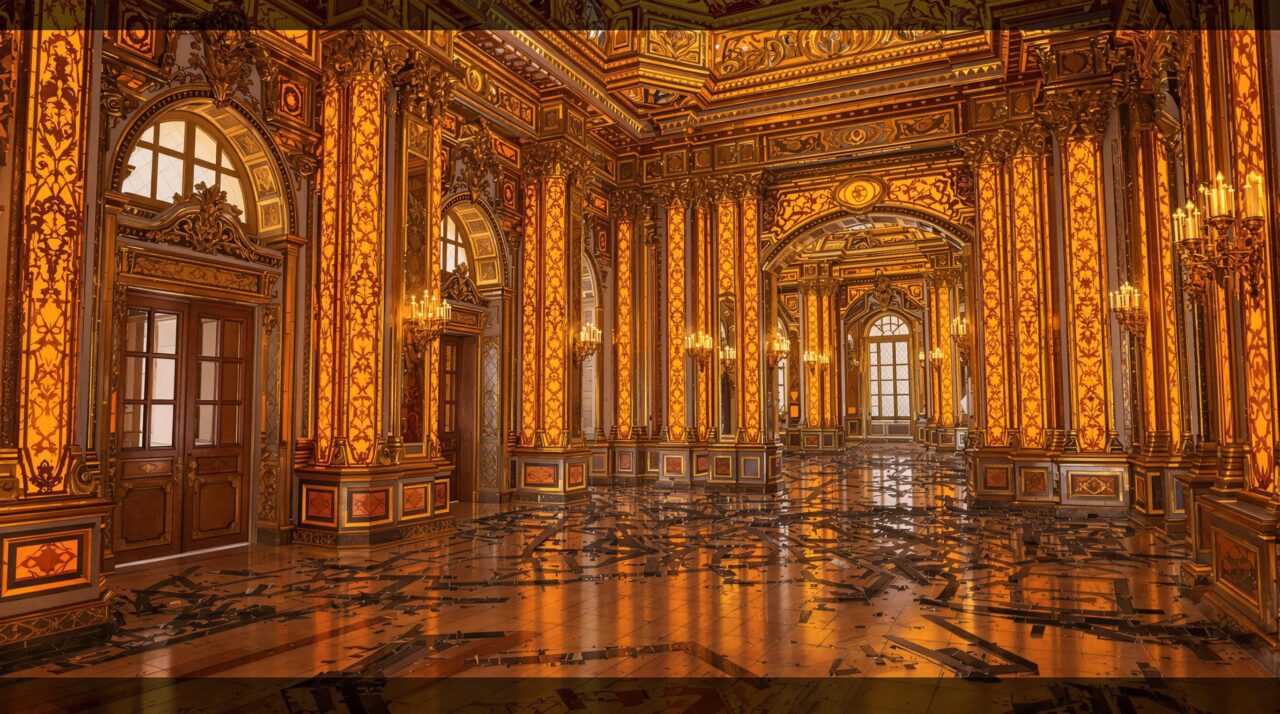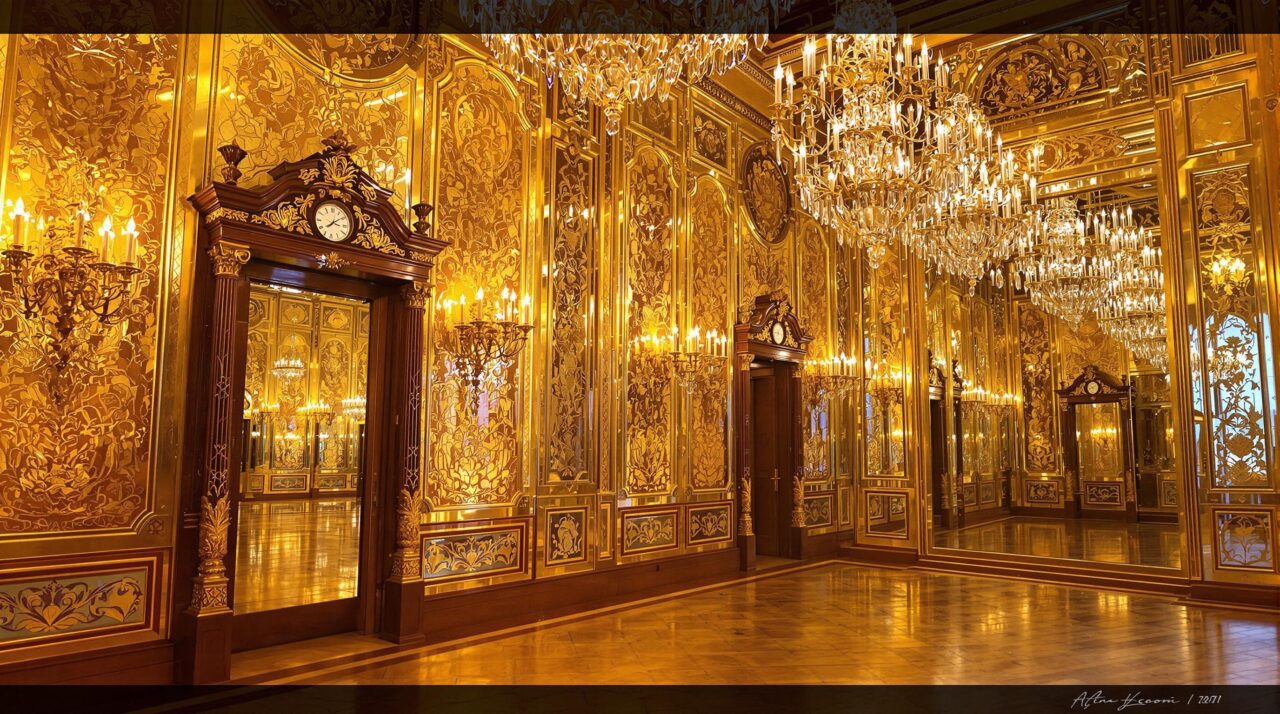Amber Room: The Lost Treasure of Russia

The Amber Room, a masterpiece of craftsmanship, once dazzled visitors within the opulent halls of the Catherine Palace.
Its golden hues and intricate amber panels whispered tales of artistry and cultural pride.
However, the shadows of World War II engulfed its beauty, leading to a disappearance that has puzzled historians and treasure hunters alike.
What secrets lie buried beneath the rubble of history? The quest for this lost treasure continues to ignite intrigue and curiosity.
Highlights
Hide- The Amber Room, crafted from golden amber, symbolizes the artistic collaboration between Prussian artisans and Russian royalty.
- During World War II, Nazi forces seized the Amber Room, leading to its mysterious disappearance and loss of cultural heritage.
- Numerous theories and speculations surround the room's fate, including hidden caches and secret tunnels within German fortifications.
- Modern expeditions and the ambitious Replica Project aim to recreate the lost masterpiece, maintaining its cultural significance.
- The ongoing mystery of the Amber Room inspires renewed passion for preserving historical art forms and safeguarding cultural heritage.
The Origins of Amber Room: A Joint Creation of Artisans

The Amber Room emerged as a breathtaking collaboration that spanned from the skilled hands of Prussian artisans to the opulent halls of Russian royalty.
Each panel, crafted from golden amber, shimmered like sunlight trapped in resin, weaving a tale of artistry and ambition.
This remarkable fusion of talent and vision transformed a simple material into one of the most coveted treasures of the age, embodying the spirit of two cultures intertwined in a quest for beauty.
From Prussia to Russia
The Amber Room, a stunning collaboration of artistry and innovation, originally took shape under the auspices of Frederick I of Prussia, who envisioned it as a gift for Tsar Peter the Great.
This intricate masterpiece, woven from shimmering amber panels and adorned with gilded embellishments, symbolized a blossoming alliance between two powerful nations.
As artisans labored over its creation, they fashioned not just a room, but a tribute to the splendor of baroque design and the enduring bonds of diplomacy.
The Initial Concept for the Prussian King
Amidst the opulent courts of 18th century Europe, the vision of a breathtaking chamber crafted from amber began to take shape, igniting the imaginations of artisans and nobility alike.
Commissioned by Frederick I of Prussia, this ambitious project united master craftsmen who meticulously assembled lively panels, each shimmering with golden hues, embodying a harmony of nature and artistry that transcended borders, capturing the essence of regal splendor.
Gifting the Masterpiece to Tsar Peter the Great
Upon the completion of the magnificent Amber Room, the masterpiece crafted under the watchful eyes of Prussian artisans found its destiny beyond the borders of its origin.
Gifted to Tsar Peter the Great, it symbolized the bond between nations. The room, adorned with golden hues and intricate designs, captivated the Russian court, embodying a shared appreciation for artistry and grandeur that transcended cultural divides.
Craftsmanship in Amber Panels
The craftsmanship behind the Amber Room’s panels reveals an extraordinary mastery of ancient techniques, where artisans meticulously cut and polished amber to achieve a radiant glow.
Each panel, adorned with intricate details, not only showcased the unique hues of the resin but also elevated the room’s allure to legendary status.
This harmonious blend of skill and artistry transformed the Amber Room into a breathtaking masterpiece, enchanting all who beheld it.
Delicate Techniques of Cutting and Polishing
Skilled artisans meticulously transformed raw amber into exquisite panels for the Amber Room, employing delicate techniques that showcased both their expertise and the unique qualities of the material.
They employed precision cutting tools to reveal amber’s warm, golden hues, while gentle polishing methods enhanced its natural luster.
Each panel emerged as a luminous work of art, reflecting light and evoking a sense of timeless elegance.
Intricate Details That Elevated Its Fame
While the allure of the Amber Room captivated many, it was the intricate details crafted by a coalition of artisans that solidified its status as a masterpiece of baroque art.
Each amber panel, adorned with delicate carvings and gilded frames, shimmered with warmth and luminescence, reflecting a dazzling interplay of light.
This meticulous craftsmanship transformed ordinary materials into an extraordinary demonstration of human creativity and collaboration.
The Room’s Glorious Days in the Catherine Palace
In the opulent halls of the Catherine Palace, the Amber Room stood as a dazzling emblem of imperial grandeur, its golden hues reflecting the flickering light of crystal chandeliers.
Lavish celebrations unfolded within its walls, where nobility gathered to honor the splendor of the Russian Empire, each event steeped in tradition and elegance.
This extraordinary chamber, adorned with intricate amber mosaics, became a symbol of prestige, enchanting all who entered its radiant embrace.
Lavish Royal Celebrations and Ceremonies
During the opulent celebrations at the Catherine Palace, the Amber Room shimmered with a golden luminescence, enchanting the eyes of diplomats and nobility alike.
Guests marveled at the intricate designs and the warm glow of amber, which seemed to echo the wealth and grandeur of the Russian Empire.
Each royal ceremony transformed the room into a dazzling stage, leaving an indelible impression on foreign envoys who were often left in awe of its beauty.
Showcasing Amber’s Radiant Glow for Diplomats
As the golden hues of amber caught the light streaming through the tall windows of the Catherine Palace, the opulence of the Amber Room became a dazzling backdrop for imperial celebrations.
Diplomats marveled at the intricate designs, where every panel shimmered with history.
The room, a symbol of power and artistry, captivated all who entered, embodying the grandeur of a bygone era.
Impression on Foreign Envoys and Nobility
The Amber Room, with its resplendent panels glimmering like liquid gold, left an indelible mark on the foreign envoys and nobility who were fortunate enough to witness its splendor.
Amidst lavish celebrations, the room became a dazzling backdrop for royal ceremonies, enchanting visitors with its intricate designs and rich history, evoking admiration and envy, a symbol of opulence that transcended borders and time.
Symbol of Russian Imperial Prestige
The Amber Room, a breathtaking marvel of craftsmanship, rose to prominence as a quintessential symbol of Russian imperial prestige within the opulent halls of the Catherine Palace.
Its golden hues and intricate designs not only captivated the senses but were meticulously maintained and enhanced over the years, ensuring its place in the hearts of nobility and visitors alike.
As whispers of its grandeur spread, the room became an architectural wonder, embodying the splendor and ambition of a nation at the height of its power.
Growing Fame as an Architectural Wonder
Amidst the opulence of the Catherine Palace, the Amber Room stood as a breathtaking tribute to Russian imperial grandeur, enchanting all who entered its gilded embrace.
Crafted from luminous amber panels and adorned with gold leaf, this architectural wonder dazzled visitors, becoming a symbol of artistic mastery.
Its intricate designs and ethereal glow reflected the ambitions of an empire, solidifying its fame as a cultural masterpiece.
Careful Maintenance and Periodic Enhancements
While the amber panels shimmered under the soft glow of candlelight, meticulous care was crucial to preserve the splendor of the Amber Room within the Catherine Palace.
Craftsmen routinely polished the panels, while artisans conducted periodic enhancements, adding intricate gilded accents.
This unwavering dedication guaranteed the room remained a breathtaking symbol of Russian imperial prestige, enchanting all who entered its resplendent embrace.
World War II and the Disappearance
As the shadow of World War II loomed over Europe, the Amber Room faced an ominous fate during the besiegement of Leningrad.
In a swift, ruthless maneuver, Nazi forces seized the opulent treasure, stripping it of its radiant amber panels and intricate gold leaf, leaving behind an empty shell where beauty once flourished.
Ultimately, the room vanished without a trace, its fate entwined in the chaos of war, prompting an enduring quest for its lost splendor.
Nazi Seizure During the Siege of Leningrad
Amidst the chaos of the Siege of Leningrad, the Amber Room, a shimmering representation of Russian artistry, fell prey to the advancing Nazi forces.
Controversies swirled around the orchestrated removal of its intricate amber panels, as meticulous documentation chronicled each transfer, yet the last confirmed sightings painted a haunting picture of disappearance.
Shadows of uncertainty loomed over the fate of this opulent treasure, leaving behind a legacy shrouded in mystery and loss.
The Controversy Over the Room’s Removal
Although the splendor of the Amber Room once captivated visitors with its intricate amber panels and golden embellishments, its fate took a dark turn during World War II, when the room became a symbol of cultural loss amidst the chaos of conflict.
The controversy surrounding its removal raised questions about heritage, ownership, and the price of war.
- Cultural identity at risk
- Art theft during conflict
- Historical significance debated
- Preservation efforts challenged
- Legacy of loss and hope
Documented Transfers and Last Confirmed Sightings
The Amber Room, once a breathtaking marvel of Baroque artistry, faced its most harrowing chapter during World War II when it was seized by Nazi forces amid the chaos of the Siege of Leningrad.
Documented transfers reveal its disassembly in 1941, leading to its mysterious disappearance. Last confirmed sightings occurred in Germany, but the treasure eluded retrieval, shrouded in whispers of lost heritage and unfulfilled dreams.
Vanishing Without a Trace
As the chaos of World War II enveloped Europe, the Amber Room vanished into the shadows, leaving behind a tapestry of whispered theories and fragmented testimonies.
Some claimed the exquisite panels were hidden in secret bunkers, while others insisted they were lost to the ravages of war, their beauty forever obscured.
Divergent accounts from wartime witnesses paint a haunting picture of a treasure slipping through time, its fate entwined with the tumult of a world at war.
Theories on Hidden Bunkers or Destroyed Treasures
While whispers of hidden bunkers and destroyed treasures swirl through the annals of World War II history, the fate of the Amber Room remains a tantalizing enigma.
Speculations abound, suggesting:
- Secret tunnels beneath German fortifications
- Disguised caches in the Bavarian Alps
- Hidden treasures lost in wartime chaos
- Soviet recovery missions gone awry
- The haunting silence of forgotten relics
Each theory tantalizes those seeking freedom from historical mystery.
Divergent Reports from Wartime Witnesses
Amidst the chaos of World War II, divergent reports from those who witnessed the Amber Room‘s last days paint a fragmented picture of its fate, leaving historians to grapple with uncertainty.
Some claimed it was hidden in secret bunkers, while others spoke of its destruction in a fiery inferno.
Each account, steeped in mystery and emotion, only deepens the enigma surrounding this lost treasure.
Modern Searches and Attempts at Reconstruction
In the decades following World War II, a relentless quest unfolded, as treasure hunters and historians initiated expeditions across the war-torn landscapes of Europe, driven by whispers of the Amber Room’s hidden fate.
This fervor culminated in the ambitious Replica Project, which sought not only to reconstruct the lost masterpiece but to breathe life back into its golden splendor, culminating in a dazzling revelation in 2003.
Each effort, a tribute to human resilience and creativity, echoes the enduring allure of this enigmatic jewel of Russian heritage.
Post-War Investigations and Expedition Efforts
In the shadowy aftermath of World War II, a series of expeditions commenced, sending teams into the depths of mines and concealed locations across Europe, driven by whispers of the Amber Room’s fate.
Historians and governments engaged in fervent debates, each claiming fragments of knowledge that might lead to its recovery, while the specter of lost artistry loomed large in the collective consciousness.
Amidst the rust and rubble, the quest for this legendary treasure transformed into a modern-day odyssey, where hope and skepticism danced in a delicate balance.
Excavations in Mines and Secret Locations
Though decades have passed since the Amber Room vanished without a trace during World War II, the allure of its lost treasures continues to ignite a fervent quest among historians and treasure hunters alike.
- Secret tunnels beneath St. Petersburg
- Abandoned mines in East Prussia
- Rumored hidden caches in Germany
- Underwater searches in Baltic Sea
- Disappearing artifacts from private collections
Debates Among Historians and Governments
The quest for the Amber Room has sparked intense debates among historians and governments, particularly as modern searches and reconstruction efforts have unfolded in the years following World War II.
Disagreements over provenance, ownership, and authenticity have fueled tensions, while expeditions through dense forests and crumbling ruins evoke a sense of lost grandeur.
Each discovery ignites hope, yet the elusive treasure remains enshrouded in mystery.
The Replica Project and Unveiling in 2003
In 2003, the world witnessed a remarkable revival as Russian artisans, fueled by a profound sense of heritage and meticulous research, commenced on the ambitious task of recreating the Amber Room.
This collaboration, a harmonious blend of ancient craftsmanship and contemporary vision, sought not only to restore the lost splendor of the original but to enchant a new generation of visitors.
As the replica took shape, the golden hues of amber glowed once more, casting a warm light on the enduring legacy of a treasure long shrouded in mystery.
Funding and Collaboration by Russian Experts
As interest in the Amber Room surged in the late 20th century, a coalition of Russian historians, craftsmen, and art restorers commenced on an ambitious journey to both locate and recreate the fabled treasure.
Their efforts were bolstered by:
- Government grants
- Private donations
- International collaborations
- Historical archives
- Modern technology
Through these resources, the dream of reviving the Amber Room began to take tangible form.
Crafting a New Amber Room for Public Viewing
Amidst a renewed fervor for the Amber Room, efforts to reconstruct this lost marvel took on a palpable urgency, culminating in the ambitious Replica Project.
Completed in 2003, artisans meticulously recreated the original’s golden hues and intricate designs, employing centuries-old techniques.
This dazzling homage not only reignited public interest but also honored the enduring spirit of a cultural treasure once thought irretrievably lost.
Why the Amber Room Captivates Historians and Adventurers
The allure of the Amber Room continues to enchant historians and adventurers alike, fueled by a tapestry of ongoing rumors and myths surrounding its fate.
This legendary masterpiece, a symbol of Russia’s cultural heritage, evokes a sense of longing for lost artistry and craftsmanship, making it a focal point of intrigue and exploration.
As tales of hidden treasures and elusive clues circulate, the quest for the Amber Room transforms into a compelling narrative of history, mystery, and the human spirit’s relentless pursuit.
Ongoing Rumors and Myths
Whispers of curses and tragic fates surround the Amber Room, casting a shadow over its storied past and igniting the imaginations of treasure hunters and historians alike.
Each tale of misfortune, entwined with the room’s elusive legacy, serves as a tantalizing lure, beckoning adventurers to unravel the mysteries that shroud its disappearance.
As speculative narratives continue to emerge, the allure of lost riches and the haunting possibility of the Amber Room’s existence keep the spirit of exploration alive.
Tales of Curses and Unlucky Fates
Mystique envelops the Amber Room, a legendary masterpiece that has sparked countless tales of curses and misfortune since its disappearance during World War II.
Historians and adventurers alike are drawn to the haunting legends surrounding its fate, including:
- Mysterious accidents befalling treasure hunters
- Whispers of spirits guarding the room
- Unexplained disappearances of those pursuing its secrets
- Historic betrayals linked to the room
- Superstitions shrouding its restoration
Speculative Stories Fueling Interest in Treasure Hunts
How does a lost treasure ignite the imaginations of historians and adventurers alike?
The Amber Room, shrouded in mystery, inspires fervent speculation. Whispers of hidden chambers and secret maps dance through the air, drawing seekers to its elusive splendor.
Each rumor, a thread woven into a tapestry of hope, fuels relentless quests, where the promise of discovery beckons like a siren’s call.
Significance for Cultural Heritage
The Amber Room, a shimmering tribute to the artistry of the 18th century, holds a profound significance that resonates deeply with historians and adventurers alike.
Its intricate design, crafted from thousands of pieces of amber and adorned with gold leaf, serves as a beacon of inspiration for artisans and museum curators endeavoring to preserve historical art forms.
As the search for this lost treasure continues, it ignites a passionate dialogue surrounding the importance of safeguarding cultural heritage against the ravages of time and conflict.
Preservation of Historical Art Forms
Throughout history, few treasures have sparked as much intrigue as the Amber Room, a masterpiece that embodies the intersection of art, history, and cultural heritage.
Its allure lies in:
- Exquisite craftsmanship
- Rich historical narratives
- Symbolism of resilience
- Unyielding quest for preservation
- Ongoing mystery surrounding its fate
These elements resonate deeply, enchanting historians and adventurers alike, and emphasizing the importance of safeguarding such irreplaceable art forms.
Inspiration for Artisans and Museum Curators
Few artifacts possess the ability to ignite the imagination of artisans and museum curators quite like the Amber Room.
Its intricate design, shimmering hues, and storied history evoke a longing for craftsmanship and artistry lost to time.
The quest for its restoration inspires a renewed dedication to cultural heritage, fueling the passions of those who seek to preserve beauty and history for future generations.
Wrapping Up
The Amber Room, a tribute to artistic brilliance, remains a haunting enigma, enchanting both historians and adventurers alike.
Its creation reflects the unity of craftsmanship, while its disappearance echoes the fragility of cultural treasures.
As modern searches reveal fragments of its past, the quest for the room symbolizes a broader pursuit—of identity, legacy, and remembrance.
In the shadows of history, the Amber Room serves as a reminder: beauty can vanish, but the desire to reclaim it endures.



